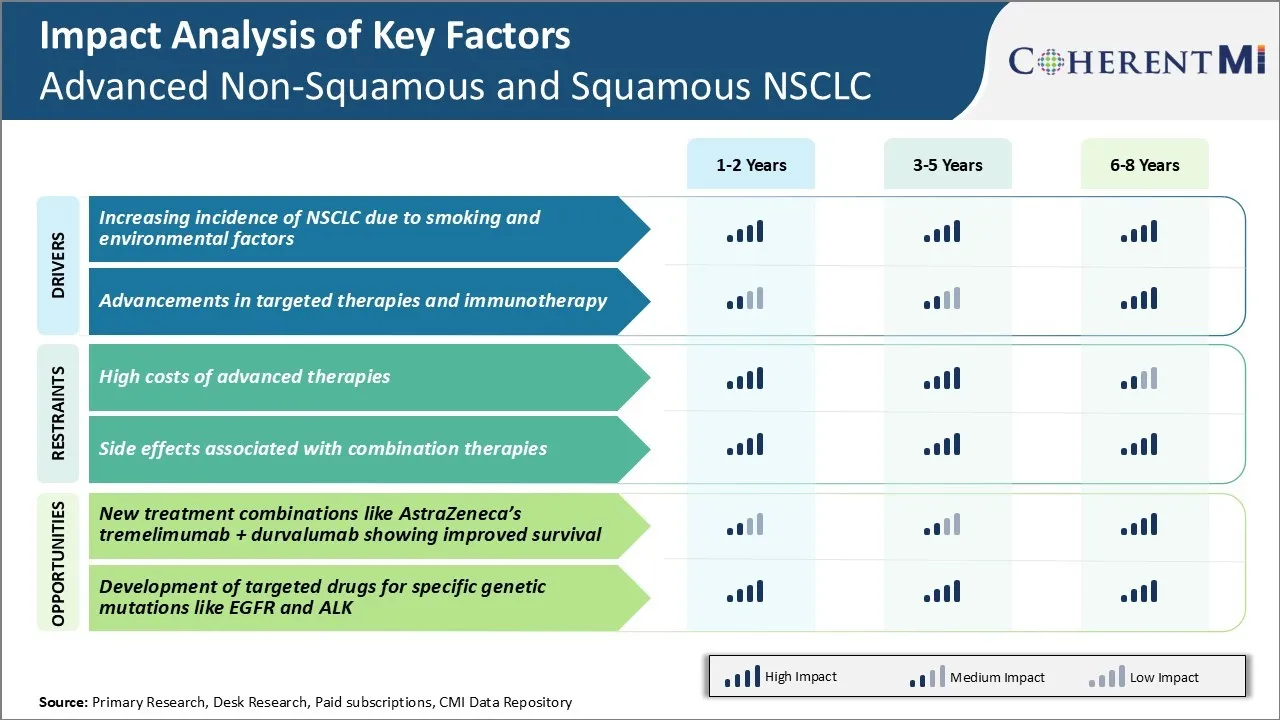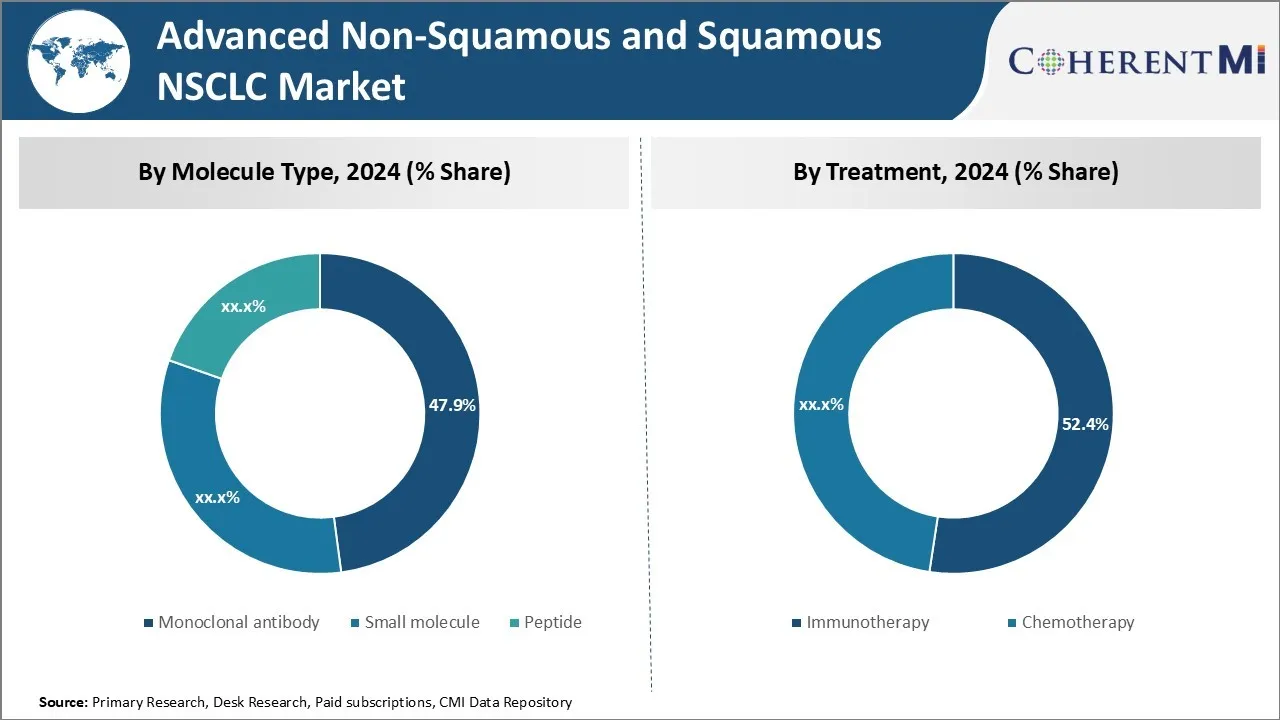高级非恒星和恒星市场 规模与份额分析 - 成长趋势与预测 (2024 - 2031)
高级非星座和星座 市场按分子类型(甲状腺抗体、小分子、丙胺)、治疗(免疫疗法、化学疗法)、疾病(非血小细胞癌、血小细胞癌)、管理途径(Oral、皮下、Intravitreal、Intramuscul)、地理(北美、拉丁美洲、亚太、欧洲、中东和非洲)。 本报告为上述部分提供了价值(10亿美元)。....
高级非恒星和恒星市场 规模
市场规模(美元) Bn
复合年增长率7%
| 研究期 | 2024 - 2031 |
| 估计基准年 | 2023 |
| 复合年增长率 | 7% |
| 市场集中度 | High |
| 主要参与者 | 阿斯特拉泽内卡, 罗什, 诺华, 辉瑞, 布里斯托尔-迈尔斯·斯基布, 江苏阿尔法玛布生物制药, 江苏兴鲁医学 以及其他 |
请告诉我们!
高级非恒星和恒星市场 分析
高级非平稳和不平稳的NSCLC市场估计价值 10.89美元 2024年学士 预计将达到 2031年之前16.58 Bn美元以复合年增长率增长 (CAGR)从2024年到2031年占7%. 在过去几年中,这一市场一直在稳步增长,预计这一趋势将在预测期间持续下去,因为全球肺癌病例的发病率不断上升,对先进有效的治疗治疗方案的需求也日益增加。
高级非恒星和恒星市场 趋势
市场驱动力 -- -- 由于吸烟和环境风险,国家航天中心发病率较高
肺癌仍然是全球与癌症有关的死亡率的首要原因,全国癌症防治中心约占所有肺癌病例的80-85%。 长期接触烟雾是肺癌发展的主要风险因素。 据估计,将近90%的肺癌死亡是吸烟造成的。
根据最近的一些流行病学研究,空气污染的威胁已成为肺癌发展的重要环境触发因素,特别是在空气质量严重受损的亚洲国家。 家庭和工作场所高水平的砷气暴露地区也出现了肺癌发病率上升。 采矿、钢铁生产、石棉加工等某些行业的工人,由于在任职期间多次吸入职业性肺癌,患肺癌的风险较高。
随着新兴经济体的持续城市化和工业化,接触室外和室内空气污染物和有毒工作场所大气的情况今后可能进一步蔓延,从而助长国家航天中心案例的上升。
市场驱动器 -- -- 定向治疗和免疫疗法的进展
支持先进的非quamous和squomous NSCLC市场的另一个显著方面是,在针对肺部恶性肿瘤的治疗和免疫治疗领域取得了相当大的进展。 传统上,化疗是治疗国家治疗中心病人的支柱。
然而,在过去十年中,我们在了解癌症途径和肿瘤生长的生物驱动因素方面取得了前所未有的进展。 这使得研究人员能够识别新颖的分子目标,并开发出能干扰对NSCLC细胞扩散和生存至关重要的特定肿瘤或生长因子受体的匹配目标药物. 一些例子包括: tyrosine kinase抑制剂在选定的患者子集中阻断EGFR或ALK聚糖蛋白的突变形式.
此外,免疫检查站抑制剂释放出身体内在的免疫防御,使肺癌治疗发生了革命性的变化. 抑制PD-1/PD-L1相互作用和恢复抗肿瘤免疫力的药物在高级NSCLC中表现出了耐久的反应,并且改善了生存结果,即使在化疗和辐射失败后也是如此. 这使得NSCLC变成了最容易接受免疫治疗的癌症之一.
在未来几年中,这些精密药品和免疫药品的更广泛供应和更多的临床使用将增加先进的非精准和精准的NSCLC市场规模。

市场挑战----高级治疗的高成本
先进的非全方位和全方位Squamous NSCLC市场面临的主要挑战之一是与较新的、先进的疗法有关的高昂费用。 由于免疫疗法和定点疗法成为NSCLC第一线和后线治疗的护理选择标准,这些疗法的费用构成重大障碍。
大多数免疫疗法每年花费超过10万美元,有些组合甚至超过20万美元进行一年的治疗. 虽然与传统化疗相比,这些先进的选择方案表明生存结果有所改善,产生了更好的总体价值主张,但短期成本仍然极高。 这种价格标签给保健系统和私人付款者带来了巨大的财政压力。
随着全球人口老化和全国医疗护理中心病例增加,治疗全国医疗护理中心病人的总费用有可能增加保健预算。 药品制造商必须研究创新定价战略和基于价值的协议,使这些拯救生命的疗法更负担得起,更方便更广泛的患者使用。
市场机会 - 新的治疗组合显示生存得到改善
在先进的非Squamous和Squamous NSCLC市场中出现的一个主要机会是新疗法组合的发展,表明生存得到改善。 AstraZeneca的免疫疗法结合了tremelimumab和durvalomab。
最近,MYSTIC试验的第三阶段数据表明,这种双重检查站抑制剂制度有助于将总体存活期延长近3个月,而前方的NSCLC治疗是化疗。 在超过两年的中位数后续行动中,这种组合使死亡风险降低了22%。 生存终点的这种改善是国家航天中心护理的转折点。
由于Tremelimumab + durvalumab 等较新的组合成为一线的有机选择,它们有可能显著延长寿命,同时提高NSCLC患者的生活质量. 这一成功突出了免疫疗法的结合,因为它是一个蓬勃发展的领域,能够推动国家航天中心治疗市场的持续增长机会。
处方者偏好 高级非恒星和恒星市场
对于元静态非静态NSCLC的一线治疗,免疫检查抑制剂日益成为护理标准. CheckMate的研究表明,硝化石(Opdivo)比多塞塔克尔的存活率有显著改善. 在Squamous NSCLC中,Keytrada(pembrolizumab)和Tecentriq(atezolizumab)也表现出了功效。
对于有EGFR突变或ALK重排的人,一线的ty基酶抑制剂,如用于EGFR+的Tagrisso(osimertinib)和用于ALK+的Alecensa(alectinib),仍然比较优先. 其令人印象深刻的响应率和较温和的描述对处方具有吸引力.
对于继铂基化疗之后的二线非quamous NSCLC,免疫疗法仍然保持其突出地位. Opdivo和Keytrada在大规模随机试验中使这个病人部分受益。 尽管潜在的与免疫有关的副作用,它们提供长期生存的能力使他们有可取的选择。
在squamous histology中,docetaxel长期作为标准的二线疗法. 然而,一些医生早些时候正在探索免疫疗法,因为他们的活动甚至在吸烟者和贫穷的PS个人中也能看到。 令人惊讶的是,如果毒性是一个主要关切问题,一个小子集仍可能转而使用单剂Gemcitabine或pemixed。
我希望这份全面而详细的报告能对处方基于疾病亚型的治疗偏好、治疗路线和具体的药物例子提供有益的见解。 如果可以进一步扩大分析内容,请告诉我。
治疗方案分析 高级非恒星和恒星市场
非小细胞肺癌(NSCLC)可归类为高级,非quamous或squamous疾病. 对于高级非整数的NSCLC,治疗取决于PD-L1状态和突变剖面.
对于PD-L1>50%,由于疗效优异,耐受性优于铂基化疗,因此倾向于使用苯丙胺(Keytruda)单疗法的一线免疫疗法. 对于PD-L1 1-49%,建议化疗加苯丙胺,以提高效果。 常见的骨干药理包括卡博白丁或带有pemixed的cisplain,用于非平整的神学.
二线选择包括docetaxel,nivolumab(英语:Opdivo),Ramucirumab(英语:Cyramza)加上docetaxel或erlotinib(英语:Tarceva)用于EGFR突变. 对于squamous NSCLC来说,一线的铂基双子化疗,包括卡宝白金或配有宝石的cisplain,paclitaxel或docetaxel是标准的.
二线选择包括docetaxel或nivolumab单疗法. 由于疗效的提高和多塞塔克素的提高,耐沃卢马布或苯丙胺的免疫疗法也是二线治疗的替代品. 化学疗法骨干根据组织学选择,以最大限度地提高疗效,同时尽量减少毒性. 免疫疗法改善了总体生存状况,由于安全情况良好,它正成为首选选择。 生物标志检测指导定向疗法.
关键参与者采用的关键制胜策略 高级非恒星和恒星市场
产品创新数字 : AstraZeneca和Roche等主要角色采取的主要战略之一是不断投资于研发,以开发新的有针对性的疗法。 例如,2018年,AstraZeneca获得了FDA对Tagrisso(osimertinib)的批准,作为EGFR变异NSCLC的一线处理. 塔格里索与传统化疗相比,生存率大大提高,并成为标准的一线疗法. 它的成功导致阿斯特拉泽内卡的市场份额不断增长.
扩大指标:Merck等玩家已成功扩展其现有药物的核定指示,以针对更多患者部分. 例如,在2020年,FDA批准Keytrada与化疗结合使用,作为元静脉或经常性非静脉性NSCLC患者的前沿疗法. 这大大扩大了凯特鲁达的可处理病人人口和市场潜力.
战略伙伴关系数字 : 为了获得新的药物候选人和技术,布里斯托尔-迈尔斯·斯基布通过联合研发协议和并购与其他公司合作。 例如,它在2019年以740亿美元收购了凯尔根,获得了新批准的NSCLC药物Revlimid的权利. 这加强了它的肿瘤学组合。 它导致Revlimid为布里斯托尔-迈尔斯·斯基布公司创造了超过120亿美元的全球销售额。
分段分析 高级非恒星和恒星市场

透视,按分子类型:定向治疗方法 处理景观
就分子类型而言,单克隆抗体预计在2024年将占有47.9%的市场份额,因为它们有针对性地对待驱动癌症发展的特定分子。 单体抗体如pembrolizumab(凯特鲁达)和nivolumab(奥普迪沃)等免疫疗法药物,开创了精准肿瘤学的新时代.
与传统化疗剂不同,这些药物可以选择性地阻断像PD-1/PD-L1这样的肿瘤细胞用来逃避免疫破坏的免疫检查站. 与化疗相比,非目标毒性最小,因此,它们显示出较高的总体存活率和耐久性。
最近批准在多种环境中的单克隆抗体,无论是流星体还是非流星体,都推动了这些抗体的吸收。 此外,对辅助诊断的需求也相应增加,以确定最有可能受益于这些疗法的病人。
透视,通过治疗:免疫疗法作为首选治疗方法出现
在治疗方面,免疫疗法预计将占2024年市场的52.4%,其驱动力在于其利用免疫系统抗癌细胞的能力。 检查点抑制剂通过激活患者自身的免疫细胞,使其识别并摧毁癌细胞,从而改变了治疗环境. 检查站抑制剂作为一线以及随后的线路治疗方案的成功提高了它们的采用率。
此外,与化疗相比,显示存活率和生活质量改善的新数据促使人们更倾向于早期的免疫疗法。 与化疗相比,这些疗法的有利毒性进一步增强了病人和医生选择免疫疗法的意愿。
透视,根据疾病:非平面 细胞癌 支配市场
就疾病而言,非quamous细胞癌占市场份额最高,原因是其流行率高于quamous细胞癌。 非quamous细胞癌约占所有肺癌的80-85%,一直是临床研究和新药物开发的主要焦点.
根据临床试验所显示的优效,一些有针对性的疗法和免疫疗法被优先或专门批准给患有高级或元静脉无癌细胞瘤的病人。 增加治疗办法的可得性以及令人鼓舞的结果,都有助于更多地采用这些药物,以治疗非quamous细胞癌症状,而不是粪便细胞癌,从而使其市场份额在整个市场上更高。
附加见解 高级非恒星和恒星市场
- NSCLC约占所有肺癌的85%,其中结膜细胞癌约占25%-30%,非结膜癌占70-75%。 这种区分对定制治疗方法至关重要,特别是在高级病例中。
- NSCLC市场发生了重大变化,特别是越来越多地使用混合免疫疗法。 AstraZeneca的durvalmab和Roche的Tecentriq为高级NSCLC制定了一线治疗基准,帮助改善病情的患者存活率。
- 吸烟和接触环境致癌物等可避免的风险因素,是国家航天中心的主要促成因素。 该疾病的高级阶段表现出更严重的症状,影响了生活质量。
- 食品药品管理局批准的基因突变的定向疗法,如基因突变疗法、ALK、ROS1等,是个性化治疗的核心。
- 治疗方式在squamous和非squamous NSCLC之间有所不同,包括基于铂的化疗和免疫检查抑制剂.
竞争概览 高级非恒星和恒星市场
在高级非平稳和平稳的NSCLC市场运营的主要球员包括AstraZeneca,Roche,Novartis,Pfize,Bristol-Myers Squibb,江苏阿尔法马布生物制药,江苏恒鲁医药.
高级非恒星和恒星市场 领导者
- 阿斯特拉泽内卡
- 罗什
- 诺华
- 辉瑞
- 布里斯托尔-迈尔斯·斯基布
- 江苏阿尔法玛布生物制药
- 江苏兴鲁医学
高级非恒星和恒星市场 - 竞争对手

高级非恒星和恒星市场
(主要参与者主导)
(竞争激烈,参与者众多。)
最新发展 高级非恒星和恒星市场
- 2024年10月,AstraZeneca宣布了第三阶段POSEIDON审判的阳性数据. 这次试验评估了治疗元静脉非小细胞肺癌(NSCLC)的Tremelimumab、durvalumab和化疗的结合。 结果显示,与单是化疗相比,接受这种结合治疗的病人的总体存活率有显著改善。 综合疗法在增强这一患者群体的生存结果方面特别有效,标志着在NSCLC治疗方面向前迈出的重要一步。
- Roche还针对Tecentriq(atezolizumab)开展复方疗法研究,以加强其在非小细胞肺癌免疫疗法市场的地位。 例如,罗切的IMPower130和IMPower150研究证明了特森特里克在结合化疗和其他剂如阿瓦斯丁(英语:Bevacizumab)时的有效性. 这些研究表明,总体存活率(OS)和无累进存活率(PFS)有所改善,这是肺癌治疗的关键措施。 这些试验的成功帮助了Tecentriq巩固了它作为NSCLC的基础疗法的作用,并进一步扩大了它在各种组合疗法中的使用。
- Erfonrilimab(KN-046),由江苏阿尔法马布生物制药公司制作,目前正在作为双特异性抗体进行第三阶段临床试验,针对PD-L1和CTLA-4两种型号,用于治疗高级平稳非小细胞肺癌(NSCLC). 该试验被称为ENREACH-LUNG-01,是一种多中心,随机,双盲,安慰剂控制的研究,旨在结合对无法分解或元静态NSCLC患者的化疗,评估KN-046的安全性和有效性.
- 江苏恒大医学研发的Pyrotinib目前正在第三阶段试验,用于治疗HER2-阳性先进固体肿瘤,包括非平方非小细胞肺癌(NSCLC). 正在进行的PYRAMID-1(NCT04447118) 第三阶段的试验旨在确认它对无累进存活的好处,而对于NSCLC藏匿HER2突变的病人来说,则要证明这种好处。 Pyrotinib是一种口服的,不可逆的泛羟基苯丙氨酸激酶抑制剂,在治疗包括乳腺癌和肺癌在内的各种HER2-乳癌方面显示出潜力.
高级非恒星和恒星市场 细分
- 按分子类型
- 单体抗体
- 小分子
- 浸泡剂
- 治疗
- 免疫治疗
- 化学疗法
- 按疾病分列
- 非组分 细胞癌
- 粪便细胞癌
- 按行政路线分列
- 口头
- 皮线
- 内部
- 内肌肉

您想要了解购买选项吗?本报告的各个部分?
常见问题 :
先进的非平稳和肮脏的NSCLC市场有多大?
先进的非平面和平面的NSCLC市场估计在2024年价值为10.89 Bn,预计在2031年达到16.58 Bn。
哪些关键因素阻碍先进的非平稳和肮脏的NSCLC市场的增长?
先进疗法和与综合疗法有关的副作用费用高昂,是阻碍先进的非平稳和平稳的NSCLC市场增长的主要因素。
哪些主要因素驱动着先进的非平稳和混乱的国安中心市场增长?
由于吸烟和环境因素以及定向疗法和免疫疗法的进步,国家中脊髓灰质炎防治中心发病率上升,是驱动先进的非平稳和平稳国家中脊髓灰质炎防治中心市场的主要因素。
哪种是先进的非平稳和平稳的NSCLC市场中的主要分子类型?
主要的分子类型段是单克隆抗体.
哪些主要角色在先进的非平稳和乱七八糟的NSCLC市场运作?
阿斯特拉泽内卡,罗什,诺华,普菲泽尔,布里斯托尔-迈尔斯·斯基布,江苏阿尔法马布生物制药公司,江苏恒鲁伊医药公司为主要球员.
先进的非平稳和混乱的NSCLC市场的CAGR将是什么?
从2024年至2031年,先进的非平稳和平稳的NSCLC市场的CAGR预计为7%.